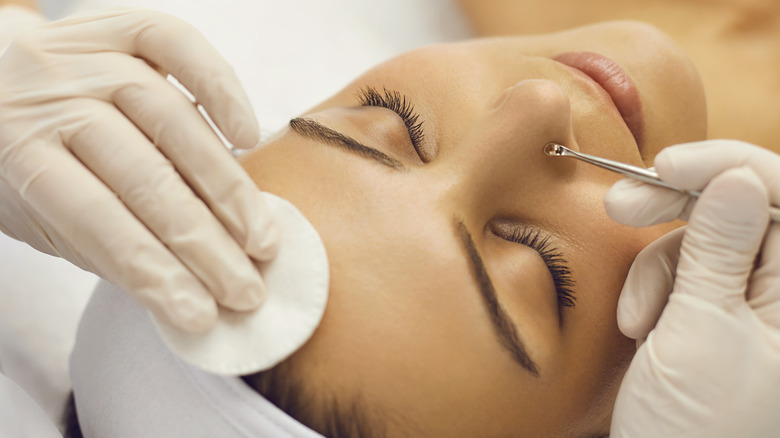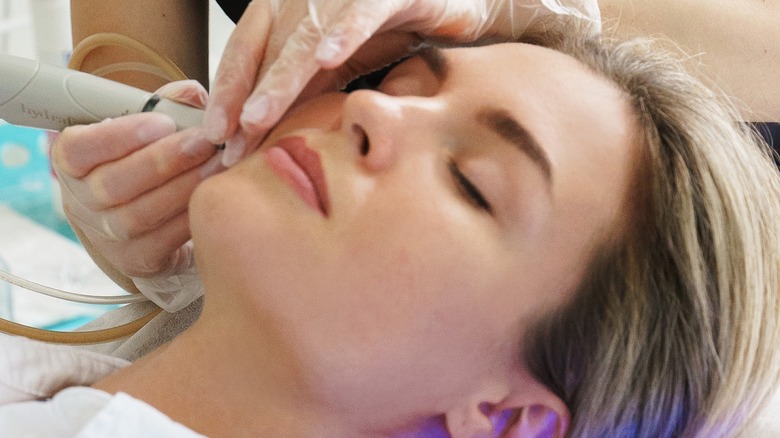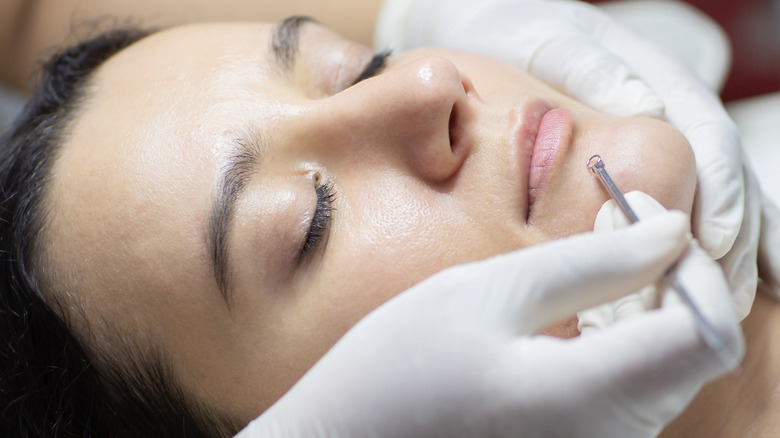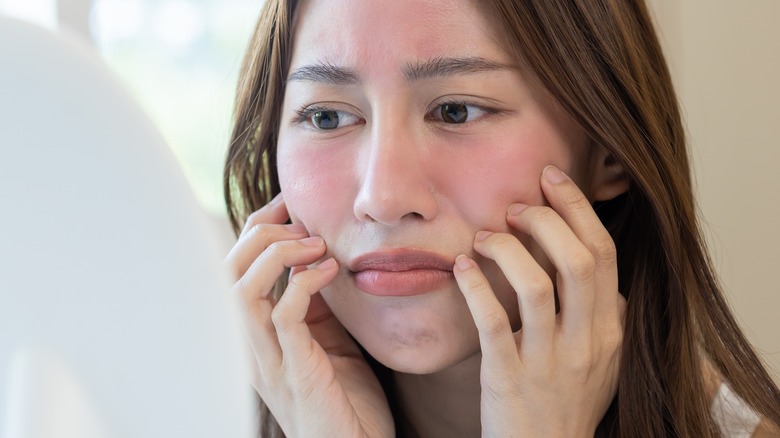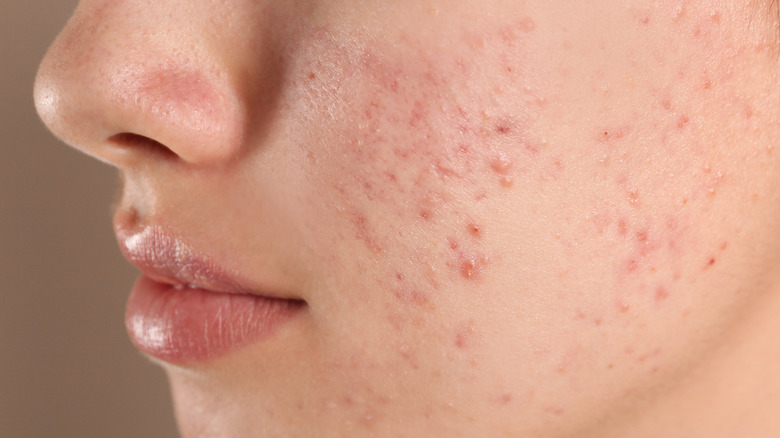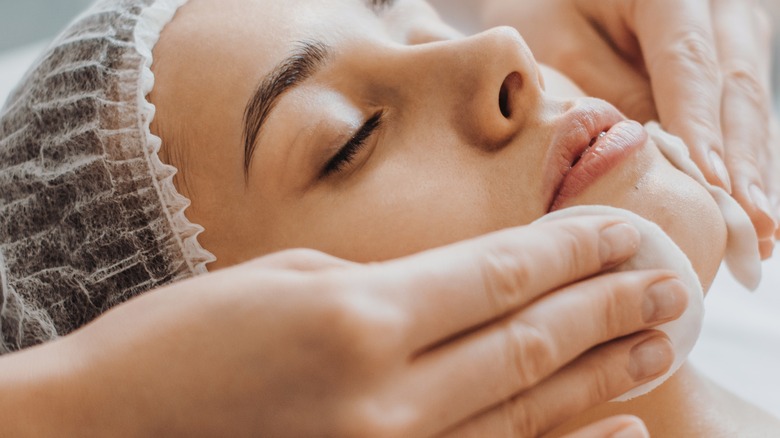Are Extractions A Must For Healthy Skin? Here's What We Know
Monthly facials are not the most important part of skincare, but they can produce remarkable results in your skin health if done properly and consistently. Getting a facial treatment at a quiet spa clinic every once in a while is a much-needed chance to let your hair down and relax while having a professional attend to your skin health in a fashion that your at-home skincare routine cannot. As far as facials go, there are numerous types of treatments you can choose from depending on your needs. Some of the most sought-after facials include intense pulsed light (IPL) therapy, microdermabrasion, peeling, facial acupuncture, and extractions.
Among these, an extraction facial is probably the most classic and common type of skin treatment prescribed for those with clogged pores or blackhead issues. A facial extraction is often likened to a form of deep pore cleansing that clears out product residue and stubborn gunk to make the skin clean and keep irritations at bay. When your pores are independent of debris, your skincare products will penetrate your skin better and are more likely to produce desirable results. "I would never ever do a facial without extractions," says esthetician Jillian Wright (via Well+Good). Wright also adds that most facial treatment bookings her clients make are for extractions. However, with so many skincare products and procedures making claims of deep pore cleansing benefits, one may wonder if extractions are still a must for healthy skin. Here's what we know so far.
What are facial extractions
A facial extraction is a procedure that involves removal of dead skin cells, debris, and makeup buildup from clogged pores to the end of keeping the skin gunk-free and preventing it from breaking out in blackheads or white heads. Your skin will become smoother and more evenly toned when your pores are clean. Also, clean pores will boost the absorption and effectiveness of skincare products.
However, facial extractions are not a permanent cure for clogged pores. Your pores get clogged with oil, dirt, and dead skin cells easily, so you'll need regular extractions to keep them clean and clear. Since our skin cell turnover cycle is 28 days long, it's ideal to have a facial extraction once or twice a month.
You will not come under general anesthesia for a facial extraction. Throughout the procedure, you might feel a little discomfort as your physician tries to nudge impurities out of your pores, but it's not the kind of pain that can knock you out. You can always tell your physician to stop and make adjustments whenever you feel like your skin needs a short break. You may experience redness and swelling right after an extraction, but they will get better after a couple of days. Your skin usually looks worse before it looks better after an extraction, which is why you should never schedule a facial extraction right before an important event.
What to expect at a facial extraction
When you arrive at an extraction appointment, the esthetician in charge will remove makeup or sunscreen from your skin, clean it thoroughly, and exfoliate it. Then, your physician will expose your face to a steaming device to open your pores and prep your skin for extraction. "Steam can help soften the skin and loosen oil and buildup in your pores," aesthetician Stephanie Diliberto tells Cleveland Clinic. "Steam your face before removing blackheads to make the plugs easier to release."
Then, the esthetician will use medical-grade equipment — like a pore extractor and a gauge — to apply gentle pressure on the clogged pore to stimulate the extraction of blackheads, closed comedones, or any gunk that gets stuck in the pore. Some pores — like red or swollen bumps — may not be ready to be extracted during the procedure and your physician might ask you to come back in a week or two when the infections have cleared up. After finishing extracting every pore that can be extracted, your physician will apply an antibacterial or antiseptic mask or serum to your freshly extracted skin and leave it on for 15 to 20 minutes to soothe the skin, minimize swelling, and restore the acid pH in your skin. Then, your face will be washed and coated with soothing moisturizer to expedite healing.
Depending on your needs, your physician might combine a facial extraction with other procedures like Isolaz treatment, vitamin C fusion, or microdermabrasion to accelerate treatment results.
Downsides of facial extractions
Since a facial extraction involves tearing that might leave scarring, it's better to leave this tough love treatment to the pros rather than using extraction tools at home yourself. Besides, everyone has different levels of pain tolerance, so those with thin or sensitive skin might find all the tugging and pulling at the impacted pores unbearable. Although facial extractions are effective for deep-cleansing pores, the protracted tearing can impair the underlying structures of the skin, weaken important skin fibers such as collagen and elastin, and deprive the skin of its elasticity. Sometimes, facial extractions can cause your skin to develop pimples and whiteheads. When your skin is overstimulated with facial extractions, it can break out into inflamed and red bumps and blemishes, which can lead to scars or hyperpigmentation.
Celebrity esthetician Renée Rouleau explains to Marie Claire: "When doing a lot of extractions to clear out bumps, sometimes not all of the lodged oil will come out and because we don't force anything that doesn't want to come out, some purging can occur a day or two after a facial as the pore does its own self-cleaning." Plus, extended steaming as part of a facial extraction can deprive your skin of its natural oils, causing redness and irritations in people with sensitive skin.
Facial extractions are not for everyone
Although facial extractions lend considerable support to your at-home skincare routine, they are not necessarily a must for everyone. Those with oily or combination skin are most likely to benefit from extractions. In most cases, a skin analysis must be conducted first to see if a person is a good candidate for facial extractions. "People who get a lot of sebaceous buildup in the T-zone area or anyone who has a lot of blackheads can benefit from extractions," esthetician Lakeisha Dale tells Bustle. Since blackheads are a form of clogged pore, they'll likely turn into pimples and impede your skin health if not extracted.
If your skin is awash with inflammatory acne lesions, it's too vulnerable for a facial extraction. Tugging at swollen bumps will only drive pus deeper into the skin and spread the bacteria, which might cause infection and swelling in other parts of your face and leave you with permanent scars. Besides, if you have a chronic facial skin condition, you should consult a dermatologist before going for any type of facial. A good rule of thumb is to only consider a facial extraction when your skin barrier is all cool and calm.
Alternative to facial extractions
If you want to tackle clogged pores without all the painful puncturing and inflammation that are common to a classic facial extraction, consider going for a Dermalinfusion. A non-surgical skincare treatment, Dermalinfusion involves exfoliating the skin using a vacuum-like device, suctioning impurities and dead skin cells from pores, and infusing the skin with a hydrating serum to keep it smooth and healthy. Not only does a Dermalinfusion therapy keep the pores clean by removing dead skin cells and impurities, but it also stimulates collagen production during the process.
HydraFacial is also a highly recommended in-office facial treatment for those looking to deep-clean their skin and improve their complexion. Similar to Dermalinfusion, it's a facial treatment where the skin is exfoliated, cleansed, and extracted using a suctioning device with a vortex effect to slough away dead skin cells and dirt at a controlled depth. Then, the skin is infused with nourishing serums for targeted treatments of skin issues like aging or hyperpigmentation. "The treatment reduces fine lines and wrinkles, increases firmness, evens tone, texture, and brown spots, as well as reducing enlarged pores," dermatologist Dr. Anna Guanche tells InStyle. Microdermabrasion — a cosmetic procedure that uses a vacuum to buff away dead skin cells and impurities — is also a go-to facial for improving skin tone and reducing fine lines.
